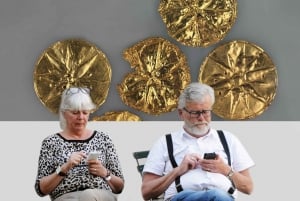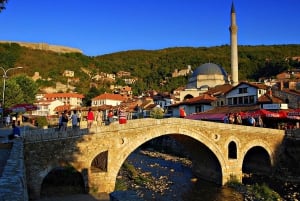Kratovo
Kratovo got its name from its location, lying on a extinguished volcano crater. Throughout the ages Kratovo has always been an important mining town from which some of the first coins in the country originated. Kratovo was known also as the city of towers and bridges, and to this very day they still remain one of the main tourist attractions.

Old Kratovo Streets (photo by: I. Nikolovski)
The towers in Kratovo were built and owned by the owners of the mines, they used to live in them together with the guards and the coins that were made from gold and silver mines. Although in total there were 13, nowadays only six remain. For protection the towers are connected with underground corridors that allowed the owners to escape the incoming ottomans together with the gold and coins. To this day the locals still believe there is a treasure lost by the fleeing owners, waiting to be found.

Kratovo Tower (photo by: Vesna Markoska)
Kratovo also had many bridges, which at the beginning of the 20-th century counted 20, nowadays there are only 4 functional left. Out of the four bridges the most famous is Radin Bridge which has its own local legend. The bridge was built by three brothers and as soon as they started to raise the bridge, it fell apart the very evening. A local prophet told them that in order for the bridge to stand, they must sacrifice one of their brides. The brothers sat down that evening and agreed, whoever's wife came the following morning will be sacrificed and put in the foundations of the bridge. The two older brothers told their wives about the plan but the youngest one did not. His wife Rada was the first to come the following morning and was thrown in the foundation of the bridge by the two older brothers. Hence the bridge got her name for eternity, Radin Most (Rada's Bridge).
The stone columns of Kuklica are one of nature's masterpiece work, 148 stone figures up to 10m high standing one next to another. These stones were formed over a period of 10 million years with the slow erosion of the soils. These stones are a popular tourist attraction because of their resemblance to actual people, hence the locals call them dolls. The locals have also created a legend that explains how the "dolls" were created. Many years ago there was a young man from the nearby village that fell in love with two girls, one very rich but not so beautiful and one beautiful but very poor. Unsure of which one to marry the young man made arrangements for a wedding with both on the same day. When the day came the beautiful and poor girl heard the drums and music from the wedding and wondered why they haven't come to her house. When she came down the valley and saw her beloved with the rich girl she cursed everyone by saying: "Let God turn every one of you into stones, even me", and when the groom kissed the bride everyone turned into stone. The locals have given a title to each of these 148 stone figures, either bride, groom, best man, cousins....

Stone Towers of Kuklice near Kratovo (photo by: I. Nikolovski)
Heading towards the border crossing with Bulgaria, Deve Bair, and an asphalt road will lead you to the monastery founded in 11-th or 12-th century “ Saint Joachim Osogovski”. Hidden in the tranquillity, lush forests and greenery of Osogovo Mountains peaks, at the altitude of 825m, Osogovo monastery is considered to be one of the most beautiful monasteries in Macedonia. The complex consists of two churches (one smaller with remnants from the 14th century, and a bigger – cathedral church dating from the 19-th century), old restored lodging houses, residential and buildings of more recent dating, economic buildings with barns and alike. The facilities for overnight stay in the monastery were built in the traditional style, used for accommodating visitors, and with the biggest overnight capacity of this kind in the whole country. The large three-nave basilica, built in 1851 by Andrey Damyanov, has 12 domes, which represent the 12 apostles, and open porches on its western and southern sides. The holy relics of Saint Yoakim of Osogovo are located to the right of the church entry, underneath the wall with the most impressive wall painting - the portrait of the saint created by Dimitar Andonov Papradishki. Iconostasis includes wood-carved Royal Doors - work of Nikola, son of zograph from Samarina. The church that wrote in its history an earthquake, demolishing from the Turks, and desolation during the entire 18-th century, today is ranked among the most distinguished cathedral churches in Macedonia built during the Revival in the first decades of the 19-th century.

Monastery of St. Joachim Osogovski (photo by: Vesna Markoska)
The monastery in Lesnovo is one of the largest, most visually stunning and culturally significant monasteries in Eastern Macedonia, with a long history that probably begins in the 11th-12th
century. Like many other medieval monasteries the Lesnovo complex composed of its monastery dedicated to St. Gavril Lesnovski and the church dedicated to St. Archangel Michail, is located up a long and imposing mountain road, on the south-western slopes of Mount Osogovo, at an altitude of about 1.118m and on the beginning of the village of Lesnovo which is spread over an old volcanic area. The Lesnovo crater is a masterpiece of nature compared by its beauty with the Vulcan Etna in Italy. The monastery is surrounded with very interesting landscape, predominately rocks, naturally shaped, among which the most impressive is one that looks like “The Virgin Mary with a Child”. The Church was built between 1341 and 1349, by the ruler Oliver 1st, on the foundations of an older shrine that existed in the 11th century during the time of the Vulnerable hermit Gabriel of Lesnovo. In the past more than 200 monks lived in the monastery, making Lesnovo great spiritual sanctuary and a centre of the medieval Kratovo literary school. According to a manuscript from the 19th century the monastery library used to hold more than 20 loads of religious manuscripts, which nowadays can be found in libraries in Belgrade, Sofia, Zagreb, Moscow, Saint Petersburg and in private libraries. The monastery is also known for its fresco-paintings dating from the time of the construction of the church and the wood-carved iconostasis from 1811, a work of art performed by the Mijak craftsman. Another curiosity is that here you’ll see a mulberry tree in form of a cross which is around 600 years old. The fruits of this tree are unusually large, delicious and black, they change the colour and the trace from them on your clothes is very difficult to remove. According to the hosts - Lesnovo monks there are only three such trees on the Balkans.

Lesnovo Monastery (photo by: Vesna Markoska)













